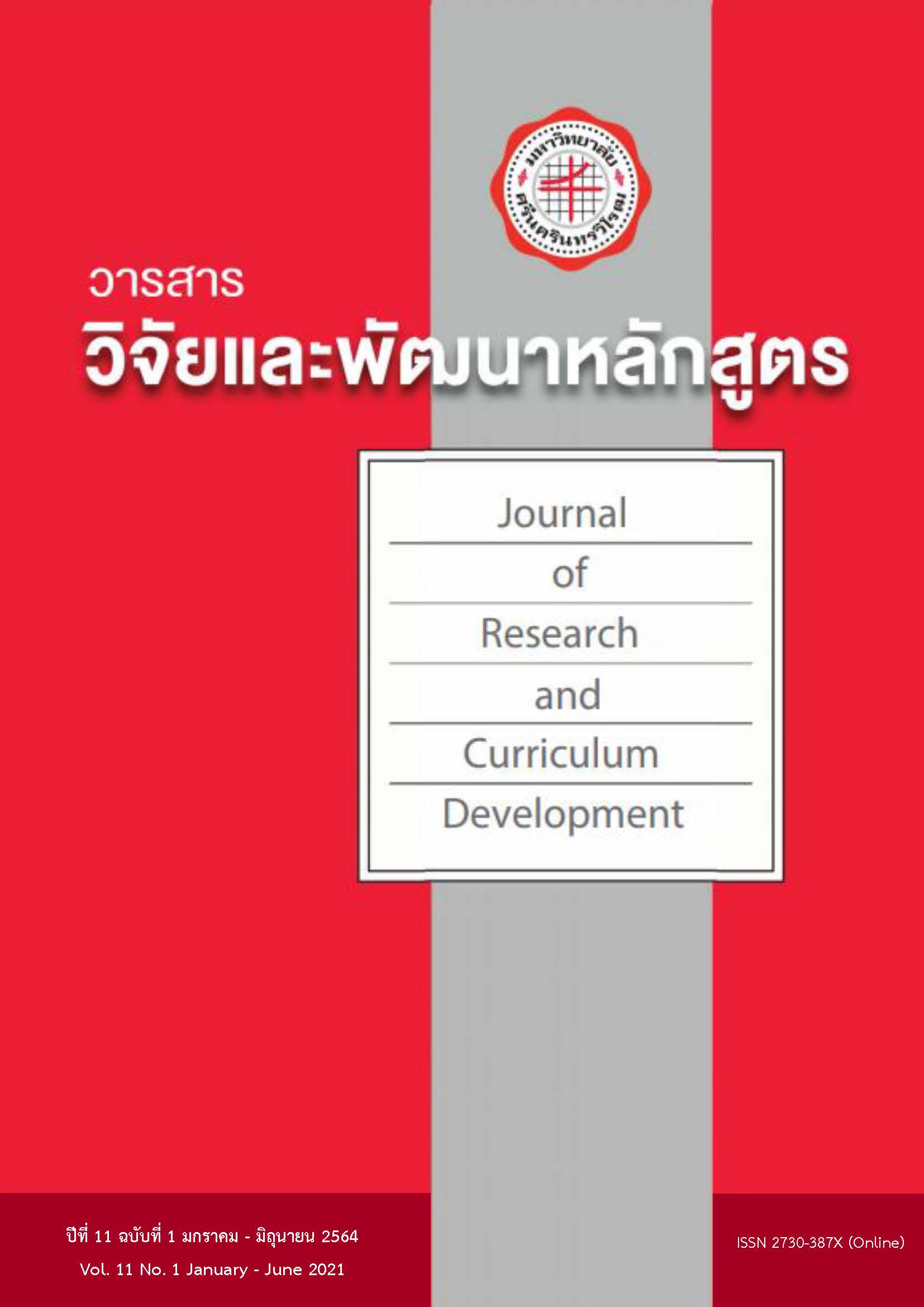การพัฒนารูปแบบการเรียนการสอนตามแนวคิด STEAM เพื่อส่งเสริมทักษะการสร้างสรรค์นวัตกรรมทางเทคโนโลยีของนักเรียนชั้นมัธยมศึกษา
Keywords:
STEAM, TECHNOLOGICAL INNOVATION CREATIVITY SKILLSAbstract
goals of this research are as follows: 1) to develop and to seek an efficient instructional model
according to the 80/80 standards; 2) to evaluate the efficiency of the instructional model development which
consists of 2.1) the comparison of the technological innovation creativity skills before and after the studies
2.2) to study opinions regarding the use of an instructional model; 3) to extend the results of the instructional
model. This research study implemented a Research and Development (R&D) blended with the embedded
design. This research tools usage 1) manual 2) units and learning management plans 3) innovation creation
notes 4) evaluation forms on innovation creativity skills and 5) opinion surveys which assess. Implementation
of instructional models with 10th grade students in Room 4/1 from the Demonstration School of Silpakorn
University. Moreover, Statistics using mean, standard deviation, and t-test values for dependent Samples.
Expanding the model application, the technological innovation creativity skills of 10th grade students in Room
4/2 from Kasetsart University Laboratory School, Kamphaeng Saen Campus Center for Educational Research
and Development. The research results indicated that 1.) the instructional 6 Ds Model is consists of 6 steps
which are 1. Define 2. Discover 3. Design, Distribute, 4. Develop, 5. Decision, and 6. Display. contained the
efficiency value equal to 80.08/85.58; the evaluation outcomes of the implementation model’s efficiency found
that 2.1.) following the model application, the students gained more technological innovation creativity skills
after the course studies ( = 2 2 . 4 3 , S.D.= 2 . 24) higher than before studies (
= 1 5 . 6 0 , S.D.= 4 . 6 2 ), at a
significant statistical level of .05; and 2.2.) the students expressed their opinion the most on the instructional
model overall opinion is at the level most agree ( = 4.40, S.D.=0.65) ; 3.) the result extension of students gaining
the technological innovation creativity skills after the course studies ( = 19.91 , S.D.= 075) higher than before
studies ( = 1 2 . 1 0 , S.D.= 0 . 5 6 ) after the course studies were higher than prior enrolling with a significant
statistical implication at the level of .05
References
HyunJu Parkและ Soo-yong Byunและ Jaeho Simและ Hyesook Hanและ Yoon Su Baek. (2016). Teachers’ Perceptions and Practices of STEAM Education in South Korea. Eurasia Journal of Mathematics, Science & Technology Education, 12(7), 1739-1753.
John W. Creswellและ Vicki L. Plano Clark. (2011). Designing and conducting mixed methods research (2 ed.). Thousand Oaks: Calif : Sage.
Pitikhate Sooraksaและ Sakda Sakorntanantและ Anurak Jansriและ Kitdakorn Klomkarn. (2016). Tree Robot: an Innovation for STEAM Education. IEEE International, Conference on Real-time Computing and Robotics, 338-341.
Ralph Katz. (2009). Innovator's Toolkit : 10 Practical Strategies to Help You Develop and Implement Innovation. Boston, MA, USA: Harvard Business Review Press.
Yakman Georgette george. (2008). STΣ@M Education: an overview of creating a model of integrative education. Pupils Attitudes Towards Technology 2008 Annual Proceedings.
ทิศนา แขมมณี. (2558). ศาสตร์การสอน : องค์ความรู้เพื่อการจัดกระบวนการเรียนรู้ที่มีประสิทธิภาพ (พิมพ์ครั้งที่ 19 ed.). กรุงเทพฯ สำนักพิมพ์แห่งจุฬาลงกรณ์มหาวิทยาลัย.
เทพกัญญา พรหมขัติแก้ว. (2557). ความรู้เบื้องต้นเกี่ยวกับการจัดการเรียนรู้แบบโครงงาน(Project-Based Learning: PBL). สสวท, 188, 14-17.
ภุชงค์ โรจน์แสงรัตน์. (2559). การพัฒนารูปแบบการสอนโดยใช้การคิดเชิงออกแบบเป็นฐานเพื่อสร้างสรรค์ผลงานที่ปรากฏอัตลักษณ์ไทยสำหรับนิสิตนักศึกษาระดับปริญญาบัณฑิต. (ครุศาสตรดุษฎีบัณฑิต), จุฬาลงกรณ์มหาวิทยาลัย, กรุงเทพฯ.
วรรณทิพา รอดแรงค้ามและ พิมพันธ์ เดชะคุปต์. (2542). การพัฒนาการคิดของครูด้วยกิจกรรมทักษะกระบวนการทางวิทยาศาสตร์ (พิมพ์ครั้งที่ 2. ed.). กรุงเทพฯ: สถาบันพัฒนาคุณภาพวิชาการ (พว.).
วิชัย วงษ์ใหญ่และ มารุต พัฒผล. (2558). กระบวนทัศน์การโค้ชเพื่อเสริมสร้างทักษะการสร้างสรรค์และนวัตกรรม. กรุงเทพฯ: จรัลสนิทวงศ์การพิมพ์ จำกัด.
วิชัย วงษ์ใหญ่และ มารุต พัฒผล. (2562). การพัฒนาทักษะสร้างสรรค์นวัตกรรม. กรุงเทพฯ: ศูนย์ผู้นำนวัตกรรมหลักสูตรและการเรียนรู้.
วิสูตร โพธิ์เงิน. (2560). STEAM ศิลปะเพื่อสะเต็มศึกษา: การพัฒนาการรับรู้ความสามารถและแรงบัลดาลใจให้เด็ก. วารสารครุศาสตร์, ฉบับที่ 1 (ปีที่ 45 ประจำเดือน มกราคม-มีนาคม 2560), 320-334.
สถาบันส่งเสริมการสอนวิทยาศาสตร์และเทคโนโลยี. (2014). คู่มือเครือข่ายสะเต็มศึกษา. กรุงเทพฯ: ศูนย์สะเต็มศึกษาแห่งชาติ.
สำนักงานเลขาธิการสภาการศึกษา. (2559). รายงานการวิจัย แนวโน้มภาพอนาคตการศึกษาและการเรียนรู้ของไทยในปี พ.ศ. 2573. กรุงเทพฯ: บริษัท 21 เซ็นจูรี่ จำกัด.
สำนักวิจัยและพัฒนาระบบงานบุคคลสำนักงาน ก.พ. (2560). ประเทศไทยในบริบทไทยแลนด์ ๔.๐ ภายใต้รัฐธรรมนูญแห่งราชอาณาจักรไทย พุทธศักราช ๒๕๖๐. กรุงเทพฯ: สำนักงาน ก.พ.
สุวิทย์ เมษินทรีย์. (2560). ปรัชญาของเศรษฐกิจพอเพียงและการพัฒนาที่ยั่งยืน:กระบวนทัศน์การพัฒนาสู่ประเทศไทย 4.0. กรุงเทพฯ: สถาบันบัณฑิตพัฒนบริหารศาสตร์.
หทัยภัทร ไกรวรรณและ ปัทมาวดี เล่ห์มงคล. (2560). การจัดประสบการณ์การเรียนรู้แบบสตีมศึกษาที่มีต่อความสามารถในการแก้ปัญหาอย่างสร้างสรรค์ของเด็กปฐมวัย. วารสารศึกษาศาสตร์ปริทัศน์ ปีที่ 32, มกราคม- เมษายน(ฉบับที่ 1), 123-133.





